
In this photo essay I hope to extend the contemplative space of what Bruno Latour (1993, 144) calls a “parliament of things” through the juxtaposition and relationing of two seemingly unrelated otherly worlds—that of debris and male same-sex desire—to gesture at what I term a bullerman erotics as an outlaw (Alexander 1994) carnality in the context of Trinidad and Tobago. The term bullerman is used derogatorily in this postcolonial nation-state to refer to men who are presumed to have sexual intimacies with other men (gay-identified, cis-identified, or otherwise) and as such is a densely laden category of non-normative gender and sexual disciplining and policing of bodies (for example, through the state’s continued endorsement of anti-sodomy legislation and the complimentary role of inter-religious homophobia). The fact that this term is used as a placeholder for male same-sex intimacy betrays the possibility of a deeper contiguous historical experience of the homoerotic that might be traced through the nation-state’s archives of the enslavement of Africans and indenturing of Indians (the two largest demographic citizen groups, which were constructed by colonial discourses as mutually incompatible). As a result of this unimaginable possibility (based on the premise of historical impossibility), homoeroticism remains hidden or visually obscure in the public sphere (although one might argue that rampant male homo-patriarchal sociality is the very system that organizes the nation as the center of collective desire—i.e., the male homosocial is perhaps the most normalized homoerotic charge). As such, this creative work is meant to visualize and thus materialize bullerman homoeroticism as a counter-public, not only as a plea for expanding the terms of gender and sexual citizenship, but more so as a trigger for diffusing disciplinary postcolonial nationalism. There is a very limited corpus of scholarly work on the politics of the bullerman’s experience (see Crichlow 2008; Glave 2008; Attai 2017). The collection therefore makes appear what might be considered Trinidad’s queer archive as a site of productive “historical unraveling” (Marshall, Murphy, and Tortorici 2014). It is based on the premise that visual anthropological research must not only seek to illustrate/mirror but creatively pry open and cunningly craft spaces of meaning, especially in the absence of written text (the hegemonic visual form).
In this regard, the images presented in this collection (Debrisn-1) might be considered as a form of counter-public glyphing of the nation’s silencing and aggressive refusal of a bullerman erotics as a legitimate site of embodied desire, intimacy, kinship, and sociality. I simultaneously deploy the term debris as an association of objects with waste, pollution, remains, garbage, junk, scrap, shadows, and ruins that are intimately bound through their otherness, while also thinking about how non-normative (gender and sexual) socialities (i.e., shadow socialities) and subjectivities are also regarded as forms of social and historical pollution to be discarded and violently erased by nationalist fictions, precisely because they are marked as outside the citizen-human dyad. Debrisn-1 therefore plays with the notion of debris as a description and a normative ascription of non-value or non-sense and thus disposability, of things that must be rendered out of sight, in a world of shadows that is discursively situated outside of reason. The collection refuses this demand for disappearance, metaphorically working with ideas about the physics of light to counter-illumine an affective-erotic-political lifeworld of bullerman subjecthood and relationality, thus critically responding to normative notions of waste, pollution, and the unimaginable. Methodologically, the collection is aimed at slanting our horizons of intelligibility to think about the possibility of homoerotic mattering by responding to the question: how do we illumine and reassemble the shadows of silenced/unwanted presences, and in doing so, how might we affectively, psychically, and politically re-world the conditions through which we come into relation to ourselves?
I approach this question through the methodology of visual assemblage, used by Jordache A. Ellapen (2018) to open up a conversation on the “pleasures of transgressive erotics,” thereby queering the officialized national archive of (im)possible desires (Gopinath 2005). Ellapen (2018) juxtaposes family photos and colonial images with staged homoerotic encounters between brown, black, and white men in South Africa—to make visible brown homoerotic possibility. By bringing seemingly unrelated image fragments into relation, Ellapen’s visual contemplation of the (im)possibility of brown queer male desire serves to radically rupture the (queer and colonial) archive. Vanessa Agard-Jones’s (2012, 331) work—although not visual per se—also “moves beyond what can be readily observed, measured, and tabulated to more ephemeral phenomena that empirical methods often fail to capture.” In her exploration of “an unstable, atomized archive of queer relation” (331), she focuses on sand as a “compelling metaphor . . . as a repository from which we might read traces of gender and sexual alterity on the landscape” (326), provoking “the silent archive” of queerness in the French Caribbean. Both Ellapen’s and Agard-Jones’s works push us to think productively and creatively about how to reference and trace absence as a metaphor—i.e., how might we trace absence when there is seemingly no linear link to an evidentiary referent (within the context of a compulsory absenting of queerness)? The images in this essay grapple with this question through the metaphor of debris. While debris—as a metaphor—tends to obscure potentiality (i.e., producing absence), I place it in relation to a staged homoeroticism, which allows me to co-index and to some extent, thwart compulsory “unwantedness” through a raging desire (hence my re-qualification of debrisas potentiality, using the index code of n-1—i.e., the potentiality of the metaphor to make absence matter).
Debrisn-1 deploys and builds on this technique by assembling two separate yet contiguous and fungible image collections (both produced by the author): Exhibit A includes photos of debris on the landscape (e.g., detrital soups [of driftwood, dead coconut branches, dead coral and other sea organisms, stones, used condoms, shards of sea glass, stones, and dried leaves], public graffiti, unwanted weeds, used earthen lamps, and muddy discharge), and Exhibit B is a series of colored line drawings/sketches of bullerman erotica created by the author as a refusal to obey the respectabilizing demand for invisibility. The images in Exhibit B aim to visualize racialized male homoeroticism using a coloring treatment to represent the embodiment of nonwhite intimacies. The line drawings were made in graphite (allotropic carbon), blended and colored with a “concocktion” of dirty water (mud from Trinidad mixed with water, symbolic of the pollution of the nation), sugar and coffee (both prime commodities of the colonial plantation economy, now a kind of postcolonial debris), and my saliva and semen (both elements of the embodied homoerotic lifeworld). Many of the drawings contain the symbol of a keyhole, representing a gateway to an ecstatic (yet melancholic) dreamworld of desire as well as desire on the part of queer bodies for release in public political space. Exhibit B is therefore productive of a kind of “carnal resonance,” which according to Susanna Paasonen (2011, 26), in her work on affect and online porn, “addresses experiences . . . through the notion of affect as gut reactions, intensities of experience, bodily sensations, resonances, and ambiguous feelings.”
In producing the composite images, various treatments were employed. For example, some of the images were converted into negatives (in Pixlr) and layered/assembled (in Adobe Photoshop) onto other images which were additionally treated with illuminated sea glass, reflected light on water, and color softening/intensification (for example, to signify orgasmic potentialities), and blending to create emphasis and visual complexity. These strategies represent ways of maneuvering and playing with light, using the language of optics and physics (such as reflection, shadow, refraction, diffusion, and diffraction), as metaphorical devices for queering the erotic. In addition, the photographic negative is a form of reversal (used to symbolize an antipodal modality) in that it is the otherness of the normative, positivist, and supposedly original referent. Seeing through the “negative” lens is thus a way of writing against the light that makes certain things disappear or more so inverting the light so that we might appear those erotic lifeworlds (bodies, desires, intimacies, and forbidden heat) that are marked as disposable, unnatural, and nonhuman. While Debrisn-1 specifically focuses on imagining a space of male homoeroticism, the collection is a wider provocation of the ways in which we all call ourselves into, as well as “disidentify” (Muñoz 1999) with, the enduring fiction of modernity as something we cannot completely refuse.
In conclusion, this experimental mixed-method photo essay contributes to the fields of visual anthropology and photography by queering their conventions of (non)engagement with feeling and desire. Writing on queer photography, Richard Meyer (Aletti, Meyer, and Opie 2015, 28) claims that “throughout the history of photography, queers have sought real or fictive archives on which to base—and from which to stage—their own sexual imaginings,” as a way of excavating “submerged” queer life. For Meyer this means experimenting with “new forms of affiliation” (Aletti, Meyer, and Opie 2015, 29), perhaps through what Catherine Opie (Aletti, Meyer, and Opie 2015, 30) terms “metaphorical photographs.” Especially in a context in which queerness is denied visibility, the metaphorical photograph (such as those in this essay), aims not solely to “discover” queer bodies and relationalities obscured by the (hetero)archive, but to insist on a radical visual legibility through “embody[ing] the presence of an absence” (Okudzeto 2015, 76). My work in this collection is based on this premise, which not only visualizes a bullerman’s homoerotic through a different lens—i.e., debris (as cross-referencing and visual incitement)—but it “smuggles”1 in a different aperture between these lenses to make possible an “apparitioning” of feeling/touching desire. In this sense, the collection is not only representative of queer photography per se, but it also queers photography’s fetish with the straightness of vision (as illustration and surveillance) by deliberately tampering with that which it makes absent. In addition, by provoking the potential connections between abandonment and desire (or “wantedness”), the work also contributes to what Elspeth H. Brown and Thy Phu (2014) have termed “feeling photography” as a queering of “thinking photography.” In this vein, the collection’s insistence on “critical voice” (Pink 2003) through mediated visual-affective interventions by the (queer) other also serves to “re-situate visual anthropology” (Pink 2003) through its resistance to visual evidence-based realism as the prioritized modality of power/knowledge. As Pink (2003, 190) reminds us: “things become visible because of how we see them rather than simply because they are observable.” The collection therefore opens up methodological questions about how to engage a visual anthropology of queer historical and affective complexity, to rework collective and individual (including my own) stories of queer desire,2 especially if we learn to see absence (and its constitutive tension with “the visual” as presence) as inciting new methodologies of affiliation (as opposed to non-evidence). According to Agard-Jones (2012, 328), “queer studies has largely had to define its archive through this kind of trace and absent-presence, searching for ways to both document and describe nonnormative modes of living and loving.” Furthermore, in her exploration of “digital-visual-sensory” ethnography, Sarah Pink (2014) especially highlights the role of “sensoriality” and desire as means of experiencing and “innovative” knowing. Creative visual ethnography therefore requires reflexivity about feeling/desire that has ethical implications for “remaining conscious of the power relations in which both the images we analyze, and we as researchers participate and are implicated” (Pink 2003, 187). The visual assemblages I offer therefore amount to a “new visual route to ethnographic knowledge” (Pink 2003, 191) in which the field is a dream-world of mash-ups and assemblings that hold incredible potential for ecstatic feeling-knowing.
Notes
1. Anonymous reviewer’s word usage.
2. Anonymous reviewer’s comment.

Download “Debris n-1: Visualizing a Bullerman Erotics” by Amar Wahab as a pdf booklet.
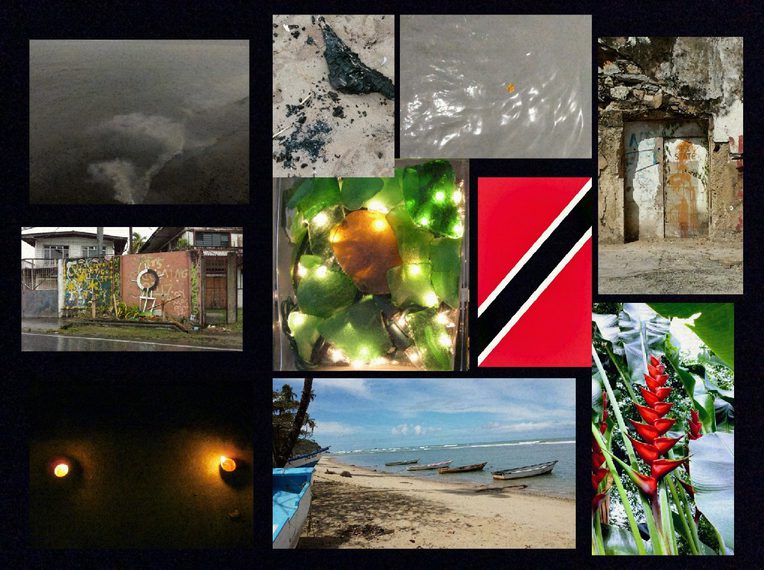
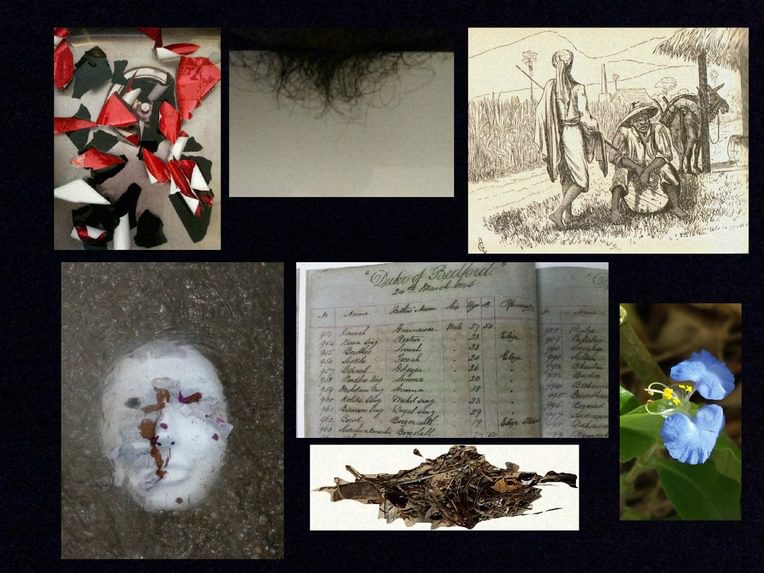
Figure 1a. Exhibit A (L to R): Muddy stream flowing into/polluting water; charcoal remains on a beach; discarded marigold flower floating on water; urban public graffiti (“No.” “State.”) on colonial wall; two panels of rural public graffiti made from a range of debris; illuminated sea glass lamp made from beach scavenging; national flag of Trinidad and Tobago; reused earthen lamps or deyas used to celebrate the Hindu festival of lights (Divali); beach scene with soup of debris; and Heliconia or balisier flower just before it is weeded out.
Figure 1b. Exhibit A continued (L to R): Down the Drain; Pubic Horizon; “Coolie and Negro” (Kingsley 1887); Yesterday’s Remains (facemask); Ship’s Register (The National Archives of Trinidad and Tobago); Detrital Soup; and Commelina erecta or blue watergrass, commonly considered a weed. All of these images represent, in some way, the normalized conception of debris as non-value and elements of disposable and discarded life. While it might be argued that the national flag of Trinidad and Tobago is a symbol of national-normative power, it also registers ambiguity in that the postcolonial nation-state is also representative of the debris of Western modernity. I wanted to develop an image that creates some visual equivalence between the Law of the Father (heteropatriarchy) and what pure natural light looks like but was unsuccessful in finding/creating an image of this invisible norm.
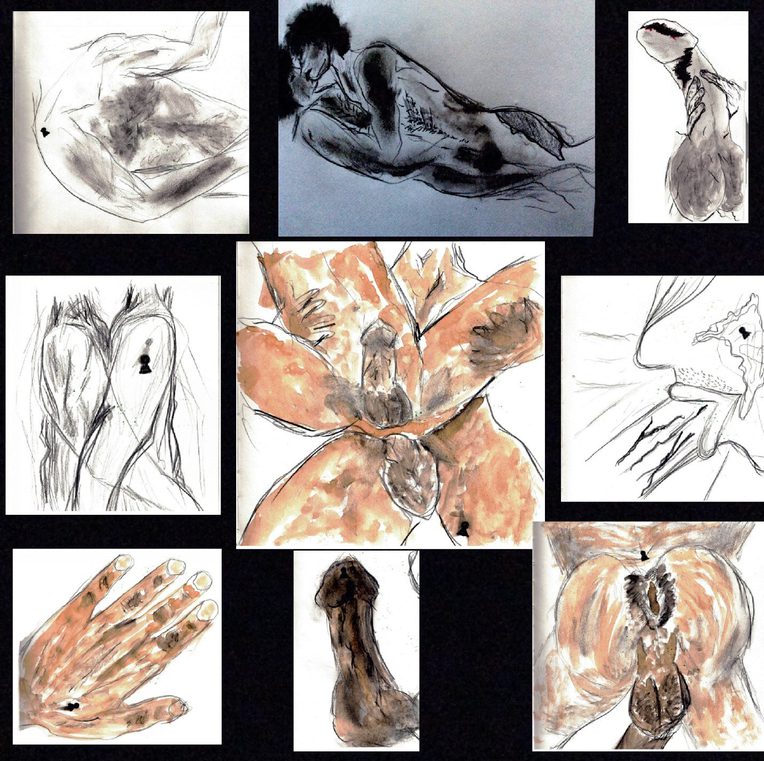
Figure 2. Exhibit B (L to R): Hot hairy chest; Lovin’ Up; Big Toti/Toli (Afro- and Indo-Trinidadian terms for penis); Embrace; Bullin’; Sucking Cock; Left-Handed Pleasure; Black/Brown Toti/Toli; and Batty Boy (popular Jamaican patois equivalent to bullerman). While some of these images reiterate stock pornographic imagery—conventionally used to visualize a western-centric white gay male erotic—they are purposely re-crafted and redeployed as a form of “sly civility” (Bhabha 1985) or critically responding to a revision of Gayatri Chakravorty Spivak’s (2003) enduring question: “Can the bullerman fuck?” (a key analytic framing a wider field of complicated desire, which might be termed the postcolonial erotic). These images therefore not only respond critically to the imprisoning forces which organize national respectability (in terms of gender and sexuality), but also to the ambiguities around dis/embodiment that organize the colonial present.

Figure 3. My Brothers’ Ghosts: A Queer Genealogy of Sweetness: This composite image blends two images of colonial production: (1) an official document of the colonial state—i.e., a ship register of Indian indentured laborers (National Archives of Trinidad and Tobago), and (2) a sketch of “Coolie and Negro” (with donkey) by Charles Kingsley (1887) depicting the mutual incompatibility of the two largest racialized labor groups in colonial Trinidad’s sugar-based plantation society. While Kingsley focused on contradistinction, I read this image of “Coolie and Negro” as a strange intimacy (regarding inter-racial sociality), especially in the curious absence of archival evidence suggesting inter-racial homoerotic relations. In the register, I wonder if there are submerged stories of male friendship, bonding, and sensuality that developed between indentured male bodies aboard coolie ships during the four-month Indian-Atlantic oceanic journeys (what I term the trans-oceanic erotic)—as an extension of the term jahaji bhai or “brotherhood of the boat” (i.e., a unique kinship and bonding of coolie men forged through their experience as “cargo” subjects). This consistent absenting of male homoeroticism in colonial discourse materializes the possibility of an invisible presence; perhaps opening up questions about the ways in which Indian and African men collectively survived everyday colonial violence through the pleasuring of each other’s bodies (i.e., an erotic kinship). In this act of unraveling a queer colonial archive, we come to understand the bittersweet of sugar as metaphor for bestial(ized) lifeworlds of subaltern pleasure in spite of the masochistic desires of colonial rule.


Figures 4a and 4b. Refracted Epiphanies (diptych): In this diptych, “Bullin’” is layered onto (naturally and artificially) lit sea glass, which refracts and slows down the velocity of light, so we might see things that we are trained/expected to lose sight of. The sea glass (with different hues of illumination) also serves to register the colorful affective intensities and shame-shattering vibrations attached to homo-passionate possibilities. These possibilities stand in tension with the nation’s hard core hetero-respectable erotic, as a form of carnal resonance (Paasonen 2011). I worked on these sketches while viewing and thinking about Mr. Pregnant’s (identifiably Afro-Trinidadian) YouTube comic confessional vlogs. In “Trinidad Buller Man” (Mr. Pregnant 2012a) he not only ecstatically confesses to bullin’ (a more hyperbolic connotation of fucking) men, but his politics of release is anchored in the positioning of white men as the bottom (penetrated) partner. Moreover, for Mr. Pregnant the white bullerman “cannot take [big fat] toti” (i.e., cannot handle black cock), which is central to his enjoyment of seeing the white bottom cry. He regards this emasculation of whiteness as a “trophy,” perhaps a return of the pain of colonial emasculation(?). In this context, how do we discipline desire into distinct markings of “(homo)sexual violence” and “erotic justice”? In “Comic Genius,” Mr. Pregnant (2012b) also performs a lush duplicitous knowing—i.e., he speaks out against anti-same-sex sentiment (as a critique of postcolonial homophobic nationalism) while also “disidentifying” (Muñoz 1999) with North American categories (gay and homosexual) that purport to hold/protect the bullerman’s experiences. Within this psychic-erotic proposal, I therefore complicate a desire for legibility through an articulation of “Bullin’” as jouissance, dissolution, and diffraction.
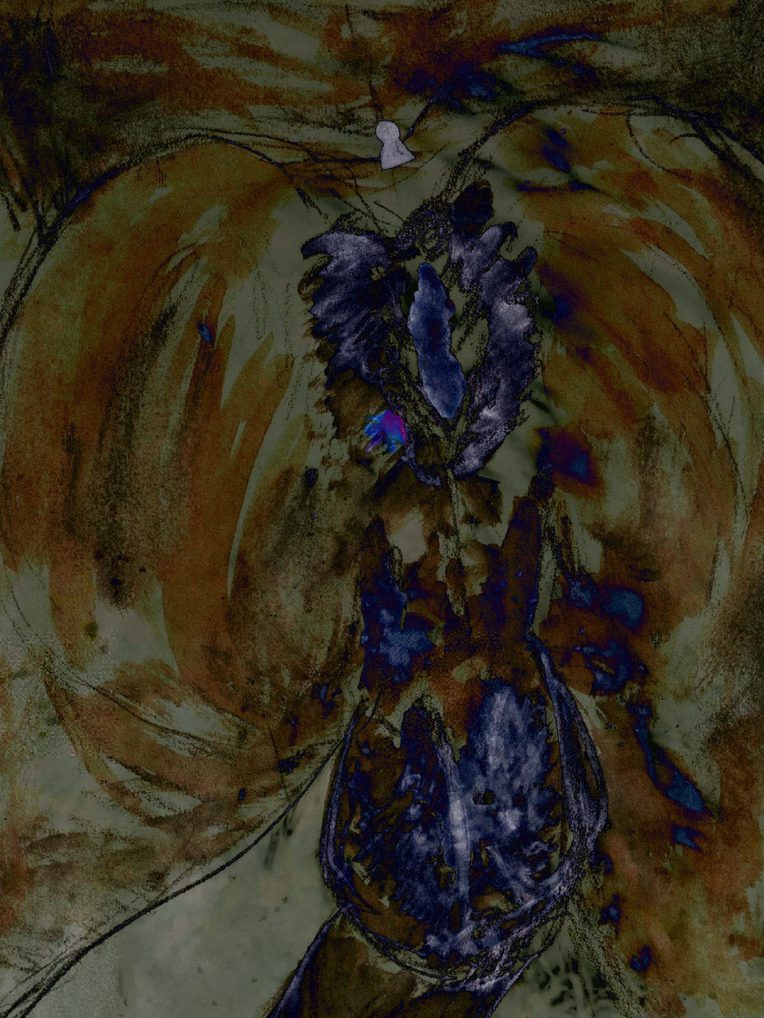

Figures 5a and 5b. V~V~V~ibrance (diptych): If Mr. Pregnant opens up the affective-erotics of anti-colonial topping, the diptych on vibrancy offers a “view from the bottom” as another modality of erotic agency (Nguyen 2014). Figure 5a juxtaposes “Batty Boy”—a Jamaican patois term that inferiorizes male bottomhood—with illuminated sea glass and beach debris (coconut husks, used condoms, etc.) to suggest an interiority of homoerotic pleasure that depends on a discarding of anal prohibition (as Law of the postcolonial patriarch), especially since the anus is a site that is normatively associated with human debris (shit) and the defilement of personhood. Instead of prioritizing penile pleasure, the image foregrounds the male perineum (that region between the anus and the scrotum) as an embodiment of homoerotic possibility. This zone of erogenous currents is often unacknowledged (i.e., not public, not political), yet is rich in dense nerve endings, thus holding the potential for a multiplication of feelings and knowings. In figure 5b the discarded yellow-gold marigold (used as offerings in sacred Hindu Trinidadian rituals) on water, juxtaposed on the perineum of “Batty Boy” (and it is interesting that there is no Indo-Trinidadian equivalent of this term) is meant to evoke a horizon-less wisdom, which depends on an understanding of passion as the constant praxis of discarding and assembling our bodies to/for ourselves.
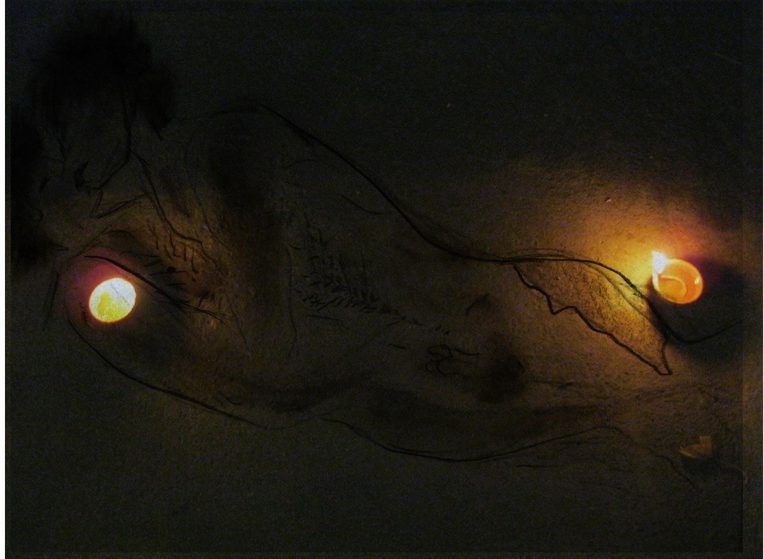

Figures 6a and 6b. Forbidden Heat (diptych): In this diptych I have layered “Lovin Up” with photos of lit earthen lamps or deyas used to celebrate the sacred Hindu Indo-Trinidadian (national) festival of lights, Divali. It is forbidden to reuse (i.e., relight) these vessels after the festival, suggesting that they are forms of debris that represent an afterlife of collective celebration. I purposely relit these deyas to think about this prohibited afterlife of light, to wonder what might be appeared in the space between lightings (permitted and prohibited), especially given that the light of the flame casts no shadow of itself. I do not aim to provide answers, but these questions evoke a certain curiousness about how we come to see some things and not others. Figure 6a responds to this desire through an image of coupled male intimacy that appears between two lit deyas (i.e., between two points of light), their light warming/illuminating different parts of both bodies, playing with appearance and disappearance of the erotic (I am also playing with the presumption that Divali is constructed as sacred and respectable, and thus outside the erotic). In figure 6b I also offer another photographic treatment (using Photoshop) of a lit deya blended with “Lovin Up” to visualize the ecstatic beauty of forbidden heat/ecstatic charge in a context (nationally and globally) in which especially brown male homoerotic (sexual-centric) intimacies are unspeakable.
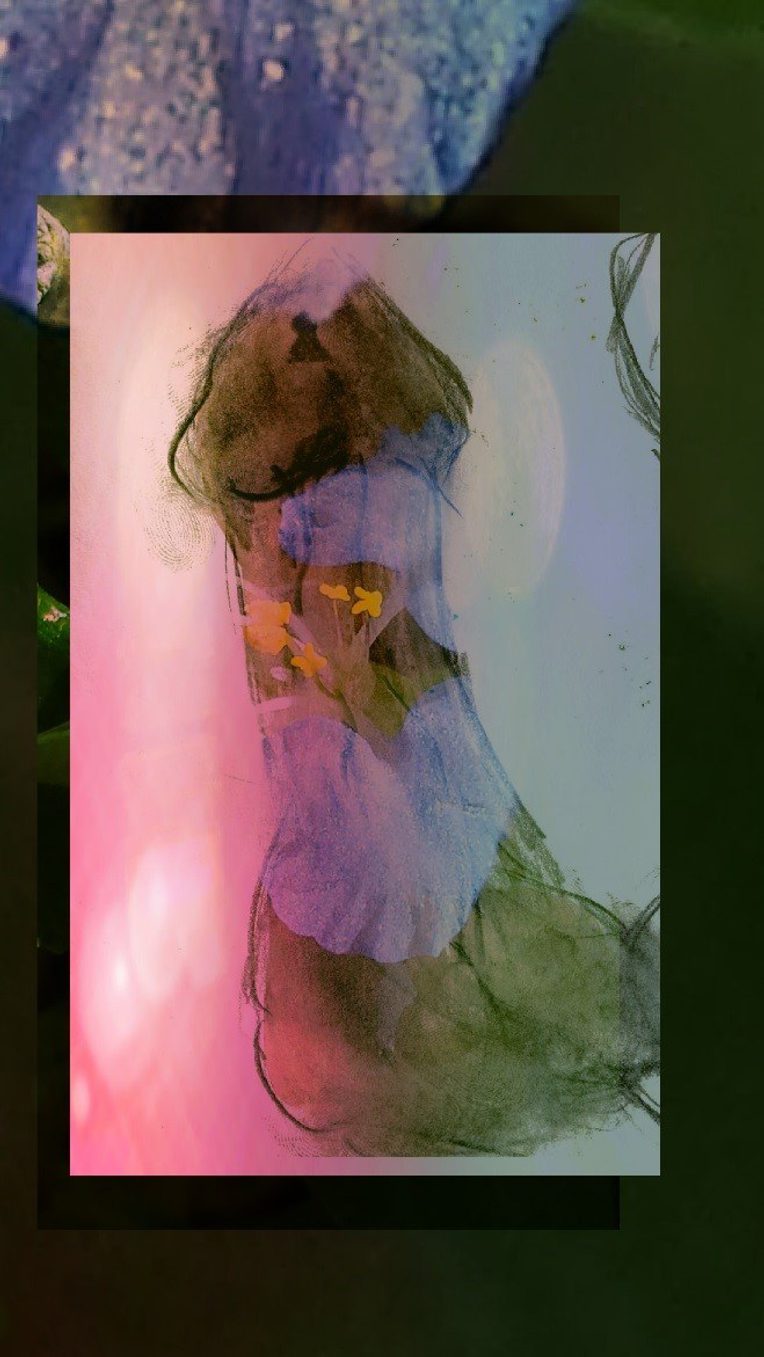
Figure 7. Weed: This composition layers “Black/Brown Toti/Toli” onto the image of blue watergrass (scientifically named Commelina erecta), which is regarded as an unwanted weed in Trinidad and Tobago. The category weed is used to symbolize how the disciplining of nature depends on the marking of alien species based on an assessed uselessness (perhaps it also resonates with the association of weed (as in marijuana) with deviance and irresponsible self-conduct). The deliberate naming of the sketch is meant to evoke the co-presence and intimacies between “Black toti” and “Brown toli” and is thus not symbolic of a single penis, but an interracial male homoerotic union. It is this union that resonates with the notion weed; for it is at once something that must be weeded out, while at the same time offering the potential for healing interracial antagonisms that often threaten national solidarity. At the very same time, this union is complicated, as it also holds the potential to expand national-patriarchy (homopatriarchy) through its disavowal of “the feminine.” This places a series of question marks around the (visual) languaging of the bullerman’s experience, within and beyond the victim–perpetrator dialectic. The lines on the margins of the sketch suggest that there is more at work.

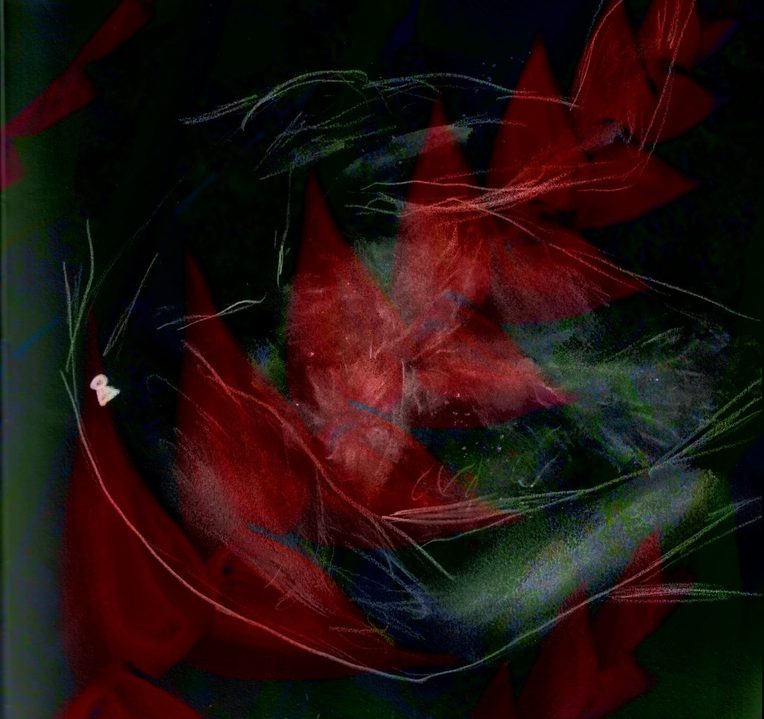
Figures 8a and 8b. Flirting Returned (diptych): In this diptych, I assemble images of charcoal (remains of a beach fire) and a Heliconia or balisier flower (locally regarded as a weed and a home for dangerous snakes) onto the negative-image of “Hot, hairy chest” to again use examples of debris as a medium for seeing erotically. In contrast to the hairless, shaved bodies that foreground Western porn, both images are meant to create an aesthetic of “not-directly-genital” sensuousness around a male chest that is hairy—and perhaps musty and charred in scent—as an object of desire. Figure 8a is a deliberate rotation of the original image of the chest to evoke a conscious desire for agency through penetration. This stands in tension with figure 8b which uses the balisier flower (as useless and dangerous) across the chest to provocatively play with the colors and design of the national flag. Both images are gestures of flirting back at the fiction of national hetero-masculinity which is secured through a regimen of (unacknowledged) homo-social flirting (i.e., an unacknowledged male, cis-erotic nationalism).

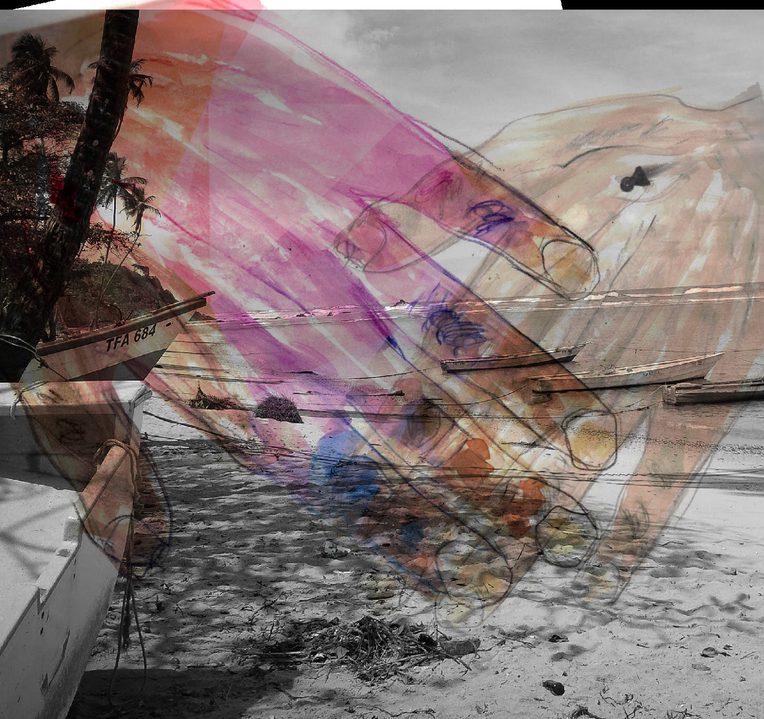
Figures 9a and 9b. The Intertidal Zone (diptych): Figure 9a layers a tracing of my own left hand onto the image of illuminated sea glass to gesture at the tactile and insertive pleasuring possibilities of the hands (e.g., masturbation, creating points of bodily pain in pleasurable tension with ecstatic release, and self-penetration as unlocking the gateway to the perineum’s promise). In figure 9b I place this hand, along with the original (“Left Handed Pleasure”) together as a way of holding erotic possibilities between men. The assembling of this composite onto a black and white version of a beach with debris (which helps to deflect the touristic homoerotic gaze), I wonder how this liminal zone—constantly submerged and exposed with the changing tides—might be indicative of hidden lifeworlds of homoerotic sociality. What could happen in these spaces when they are not constantly guarded? In posing this question, I critically respond to Western racist and homonationalist rhetoric which presumes that if these nonwhite homoerotic lifeworlds are not visually evident (i.e., if “the racialized homosexual” is not out of the closet) then they can only be made legible through a discourse of unfreedom.




Figures 10a, 10b, 10c, and 10d. In-Spite: All four figures in this installation aim to counter nationalist rhetoric of forbidden love between men that is not organized around hegemonic conceptions of bio-social (national) regeneration. Figure 10a layers “Embrace” onto a photo of mud contaminating a “pure” body of water to signal how this kind of tactile embodied love between men is regarded as pollution. Figure 10b is a magnification of Figure 10a, which is color-treated in Pixlr, to push for a rethinking of this pollution as the manifestation of a certain kind of erotic brilliance which we are without the language to make sense of. Figure 10c layers “Embrace” onto the national flag to suggest that these bodies are positioned in a tentative and tenuous relation to hetero-respectable gender and sexual citizenship. The black stripe (of the flag) which now morphs into a mark of prohibition across the embraced bodies speaks to that possibility of queer erotic kinship that is forbidden. The image is thus the visual-legal representation of the country’s Sexual Offences Act. In response to this representation of compulsory “national homophobia,” figure 10d suggests that in spite of regulatory fictions, bullerman intimacies persist (indicated by the layering of images of my own pubic hair at the top and bottom of “Embrace”).


Figures 11a and 11b. On Edge (diptych): The two images attempt to map the erotic sphere as one that is organized around categories of the urban and rural (as this is a key—yet often unacknowledged—organizing feature of Trinidadian society) through counter-public cultural production. Figure 11a combines an image of graffiti (with the words “No” and “State”) on an old colonial building in an urban space, with that of a bruised erect penis being controlled by a hand. This image is meant to suggest a visual refusal (“NO”!) of the phallic state’s regulation, in this case, of male homoerotic possibility. Yet, to suggest that this counter-politic is primarily urban is to imply that the space of rurality is not “queer.” In figure 11b I critically respond to this construct by layering an image of an installation in a rural community (primarily made from scraps of wood, Christmas decorations, discarded paint, and dilapidated walls of abandoned houses that was made by someone who is regarded as human debris—i.e., marked as a drug user, unemployed, and scavenger of other people’s garbage) with “Hot, hairy chest” to push for a reconceptualization of erotics as a wider terrain of sensuousness (even beyond the bullerman erotics). The blue color treatment activates a porno-graphic way of looking (as in the term blue movie), although I argue that the creative charge of the actual installation intimates a rural erotic, which embraces and derives agency in spite of its marginal location/status. The question I am attending to here is: how do we come to recognize each other’s beauty in contexts that are saturated with otherness?
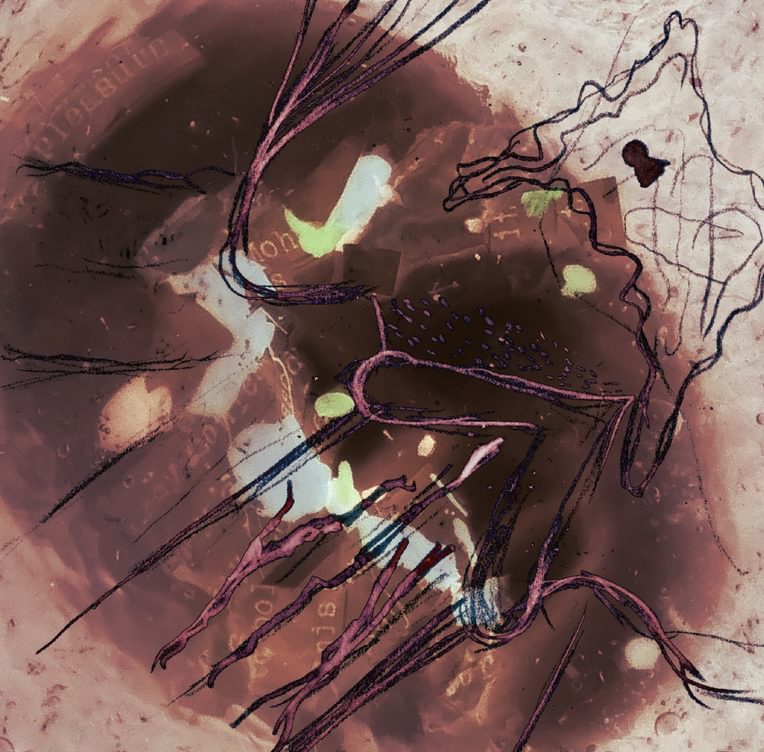
Figure 12. Return to the Future: This final assemblage looks to the future with a sense of melancholic ambivalence (i.e., not hope, which is the very condition of futurity). It layers onto a negative-image of “Sucking Cock,” an image of a mask partly covered with excerpts of an alleged sodomy case (in 1898) in the colonial Caribbean, to refocus on the colonial regulation of sexuality and desire (e.g., the British colonial Offences Against the Person Act, which is the foundation of Trinidad’s postcolonial Sexual Offences Act). This articulation of pleasure and prohibition—as organizing the historical present—also aims to expand our affective-erotic-political horizons of intelligibility about the postcolonial nation as disciplined, penetrated, and emasculated under (neo)colonialism and neoliberalism. In this regard, perhaps the structures of experience of “the bullerman” and “the postcolonial nation” are not that opposite, since they share a certain kind of kinship in the Caribbean’s unfinished colonial story of vulnerability? Especially given the recent (quasi-successful) challenge to Trinidad’s buggery law (see C-News Live 2018), I wonder ambivalently about the generative potentials of the bullerman’s erotics (even in the absence of legal prohibition), if we cannot access a visual language that helps us to reconceptualize shared vulnerabilities (i.e., how do we not continue to lose sight of each other in plain sight?).
References
Agard-Jones, Vanessa. 2012. “What the Sands Remember.” GLQ 18, nos. 2–3: 325–46.
Aletti, Vince, Richard Meyer, and Catherine Opie. 2015. “Queer Photography?” Aperture 218: 25–31.
Alexander, M. Jacqui. 1994. “Not Just (Any) Body Can Be A Citizen: The Politics of Law, Sexuality and Postcoloniality in Trinidad and Tobago and the Bahamas.” Feminist Review 48, no. 1: 5–23.
Attai, Nikoli. 2017. “’Bullerman Carnival’: Tourism and the Praxis of Caribbean Sexuality in Trinidad and Tobago.” Seminar abstract, St. Augustine, Trinidad and Tobago: Institute for Gender and Development Studies, University of the West Indies.
Bhabha, Homi K. 1985. “Sly Civility.” October 34: 71–80.
Brown, Elspeth H., and Thy Phu, eds. 2014. Feeling Photography. Durham, N.C.: Duke University Press.
C News Live. 2018. “Clashes Outside Court as Judge Rules in Favour of Gay Activist Challenging Buggery Law.” C News Live, April 12. Video, 2:49.
Crichlow, Wesley E. A. 2008. “History, (Re)Memory, Testimony, and Biomythography: Charting a Buller Man’s Trinidadian Past.” In Our Caribbean: A Gathering of Lesbian and Gay Writing from the Antilles, edited by Thomas Glave, 101–31. Durham, N.C.: Duke University Press.
Ellapen, Jordache A. 2018. “Queering the Archive: Brown Bodies in Ecstasy: Visual Assemblages, and the Pleasures of Transgressive Erotics.” Scholar and Feminist Online14, no. 3.
Glave, Thomas, ed. 2008. Our Caribbean: A Gathering of Lesbian and Gay Writing from the Antilles. Durham, N.C.: Duke University Press.
Gopinath, Gayatri. 2005. Impossible Desires: Queer Diasporas and South Asian Public Cultures. Durham, N.C.: Duke University Press.
Kingsley, Charles. 1887. At Last: A Christmas in the West Indies. Vol. 14. London: Macmillan and Company.
Latour, Bruno. 1993. We Have Never Been Modern. Translated by Catherine Porter. Cambridge, Mass.: Harvard University Press.
Marshall, Daniel, Kevin P. Murphy, and Zeb Tortorici. 2014. “Queering Archives: Historical Unravelings.” Radical History Review 2014, no. 120: 1–11.
Mr. Pregnant. 2012a. “A Comic Genius: Trini Shit Talk (122/110) Bullerman.” Video, 1:28.
———. 2012b. “Trinidad Buller Man.” Video, 1:30.
Muñoz, José Esteban. 1999. Disidentifications: Queers of Color and the Performance of Politics. Minneapolis: University of Minnesota Press.
National Archives of Trinidad and Tobago. Indentureship Ship Register (1846). Port of Spain, Trinidad and Tobago.
Nguyen, Tan Hoang. 2014. A View from the Bottom: Asian American Masculinity and Sexual Representation. Durham, N.C.: Duke University Press.
Okudzeto, Senam. 2015. “Lyle Ashton Harris.” Aperture 218: 76–83.
Paasonen, Susanna. 2011. Carnal Resonance: Affect and Online Pornography. Cambridge, Mass.: MIT Press.
Pink, Sarah. 2003. “Interdisciplinary Agendas in Visual Research: Re-situating Visual Anthropology.” Visual Studies 18, no. 2: 179–92.
———. 2014. “Digital–Visual–Sensory-Design Anthropology: Ethnography, Imagination and Intervention.” Arts and Humanities in Higher Education 13, no. 4: 412–27.
Spivak, Gayatri Chakravorty. 2003. “Can the Subaltern Speak?” Die Philosophin 14, no. 27: 42–58. Originally published in 1988.